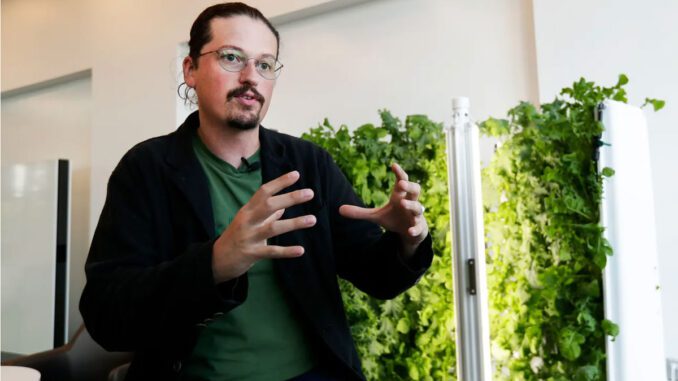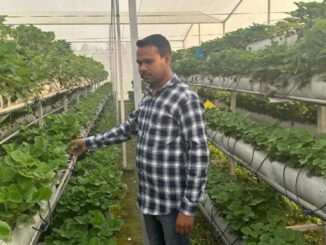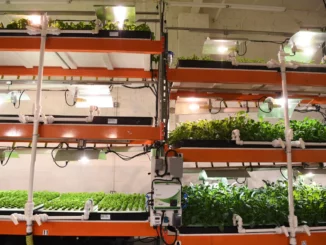
This Green Bay startup enables schools, pantries to grow their own food
Flex Farm Systems | Jeff Bollier |
Alex Tyink feels like this is another one of those key moments.
It might not be as big as the rooftop farm in Brooklyn, the “aha!” that came with his first bite of food he grew, or the “eureka” moment when the science behind his company, Fork Farms, clicked.
On the other hand, it could turn out to be bigger.
People worldwide struggle with hunger, access to nutritious food, and climate change. And Fork Farms offers food pantries, community organizations, schools and businesses the opportunity to grow food on-site — food that’s cheaper to grow, stays fresh longer and cuts carbon emissions in the process.
“My passion has always been about, how far can this go? What is this idea? How far can we really take it?” Tyink said.

Striking the right chord
Tyink is an opera singer-turned-entrepreneur who developed the Flex Farm, a very energy- and water-efficient hydroponic method to grow pounds of fresh vegetables indoors in a very small amount of space. It’s newly introduced cousin, the Flex Acre, scales up the concept to a size more suitable for feeding a much larger number of workers, students or customers.
His journey took him from his hometown of Appleton to New York City where, thanks to a young artist apprenticeship, he was pursuing a career singing opera. But it just wasn’t working.
He was a literal starving artist at the time, missing the expansive outdoor spaces accessible in Wisconsin, feeling claustrophobic in New York’s sea of skyscrapers. His mental health suffered. Then someone invited him to help grow food on a Brooklyn rooftop for a nonprofit that distributed the food to pantries.
“I didn’t even really realize urban agriculture was a thing. I didn’t know anything about vertical farming or hydroponics,” he said. “But I was really drawn to this location and the vision of the organization.”
He was given some of the food he’d grown to take home to eat. His eating habits changed “almost overnight,” his mental health improved, and he felt connected to the plants he grew. He’d found a new tune to sing: Help feed the world by decentralizing the food supply chain.
“It was weird how right it felt. For me, the opera thing, there was always something about it I was trying to figure out,” Tyink said. “When I found this, everything clicked for me. I never really looked back. I caught the bug and it became such an obsession and a passion. It was something I had to do.”

How does the Flex Farm work?
Tyink wanted to bring gardening indoors, since the growing season didn’t align with school years and the need for fresh vegetables was year-round. He started looking into existing indoor, hydroponic systems, but found them too small, too complex or too expensive.
There had to be a better way.
Early on, he tinkered away in his apartment. He bought all the grow lamps. He tried various configurations until he found one that works thanks to two scientific phenomenon you’ve never heard of.
“Albedo” measures how much sunlight reflects off a surface, as best evidenced by the supernova-like brightness of a sunny, post-snowstorm day. The Inverse-Square Law dictates the farther you get from a light source, the light intensity decreases exponentially.
In short, Tyink found that the right kind of light in the middle of the right reflective surfaces could optimize plant growth and significantly reduce the energy and water it took to do so. The result, the Flex Farm, is an octagon-shaped, hinged cabinet with plant spaces surrounding a light tower. A nutrient solution is fed to the plants through a closed water system. Closed, it takes up about 10 square feet of space.
The industry standard for vertical farming right now is about 18 kilowatts-per-pound of food, he said; the average Flex Farm customer needs 4.6 Kw-per-pound. To grow the same amount of food, a conventional farm would need 100 gallons of water to the Flex Farm’s two gallons. Customers now report growing food for as little as $1 per pound.

Becoming the Lettuce King of Appleton
Once Tyink had the concept, he started to think about the Flex Farm as a business while still in New York City. He was in for a rude awakening.
“I thought I was going to become the Lettuce King of Brooklyn,” Tyink said. “Then I saw the real estate prices in Brooklyn and I thought, ‘Well, maybe I can be the Lettuce King of Appleton.’”
Read MORE from the Original Article HERE: https://www.greenbaypressgazette.com/story/money/companies/2023/09/18/green-bay-startup-fork-farms-helps-pantries-schools-grow-food/70826265007/



